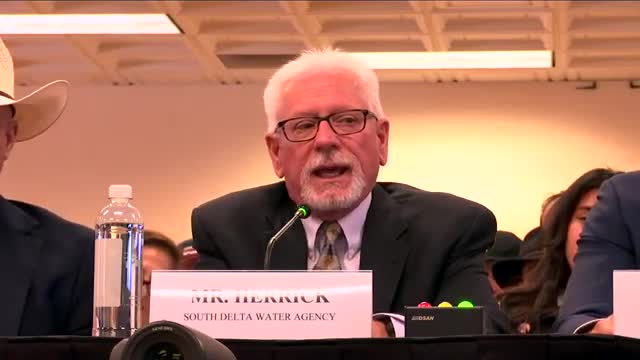Water Crisis Deepens as Drought and Silt Choke Farmland
September 06, 2024 | Natural Resources: House Committee, Standing Committees - House & Senate, Congressional Hearings Compilation
This article was created by AI summarizing key points discussed. AI makes mistakes, so for full details and context, please refer to the video of the full meeting. Please report any errors so we can fix them. Report an error »

In a recent government meeting, officials discussed the critical water shortages affecting California's agricultural regions, highlighting the urgent need for improved water management and infrastructure. The Pescadero Reclamation District has faced severe challenges, with water levels in its channels dropping to just 10% of historical averages during last summer's extreme heat wave. Farmers reported operating at only 33% of their diversion needs, leading to significant frustration among agricultural stakeholders.
The meeting also addressed the ongoing silt accumulation in key waterways, particularly the Middle River, which has seen its channels reduced to mere inches in depth, severely limiting water flow. This degradation threatens approximately 20,000 acres of farmland reliant on these water sources. Officials noted that millions of cubic yards of silt have built up in the South Delta, exacerbating the water crisis.
Josh Weimer from the Turlock Irrigation District emphasized the importance of innovative reservoir management, citing their advanced hydrological modeling that has allowed for effective flood control and water conservation during recent droughts. He pointed out that despite California's history of water abundance, the lack of investment in new storage facilities has led to chronic shortages, particularly during dry years.
Congressman Tom McClintock criticized regulatory barriers that hinder the construction of new reservoirs, arguing that the state has not built a major reservoir since 1979, despite significant voter-approved funding for water projects. He stressed that the responsibility for water shortages lies not with nature, but with policy decisions made over the decades.
The discussions underscored a consensus among officials and stakeholders that immediate action is necessary to address California's water management challenges. This includes not only enhancing existing infrastructure but also reevaluating regulatory frameworks that currently limit the state's ability to respond effectively to both drought and flood conditions. The meeting concluded with a call for collaboration among local, state, and federal entities to develop sustainable solutions for California's water future.
The meeting also addressed the ongoing silt accumulation in key waterways, particularly the Middle River, which has seen its channels reduced to mere inches in depth, severely limiting water flow. This degradation threatens approximately 20,000 acres of farmland reliant on these water sources. Officials noted that millions of cubic yards of silt have built up in the South Delta, exacerbating the water crisis.
Josh Weimer from the Turlock Irrigation District emphasized the importance of innovative reservoir management, citing their advanced hydrological modeling that has allowed for effective flood control and water conservation during recent droughts. He pointed out that despite California's history of water abundance, the lack of investment in new storage facilities has led to chronic shortages, particularly during dry years.
Congressman Tom McClintock criticized regulatory barriers that hinder the construction of new reservoirs, arguing that the state has not built a major reservoir since 1979, despite significant voter-approved funding for water projects. He stressed that the responsibility for water shortages lies not with nature, but with policy decisions made over the decades.
The discussions underscored a consensus among officials and stakeholders that immediate action is necessary to address California's water management challenges. This includes not only enhancing existing infrastructure but also reevaluating regulatory frameworks that currently limit the state's ability to respond effectively to both drought and flood conditions. The meeting concluded with a call for collaboration among local, state, and federal entities to develop sustainable solutions for California's water future.
View full meeting
This article is based on a recent meeting—watch the full video and explore the complete transcript for deeper insights into the discussion.
View full meeting